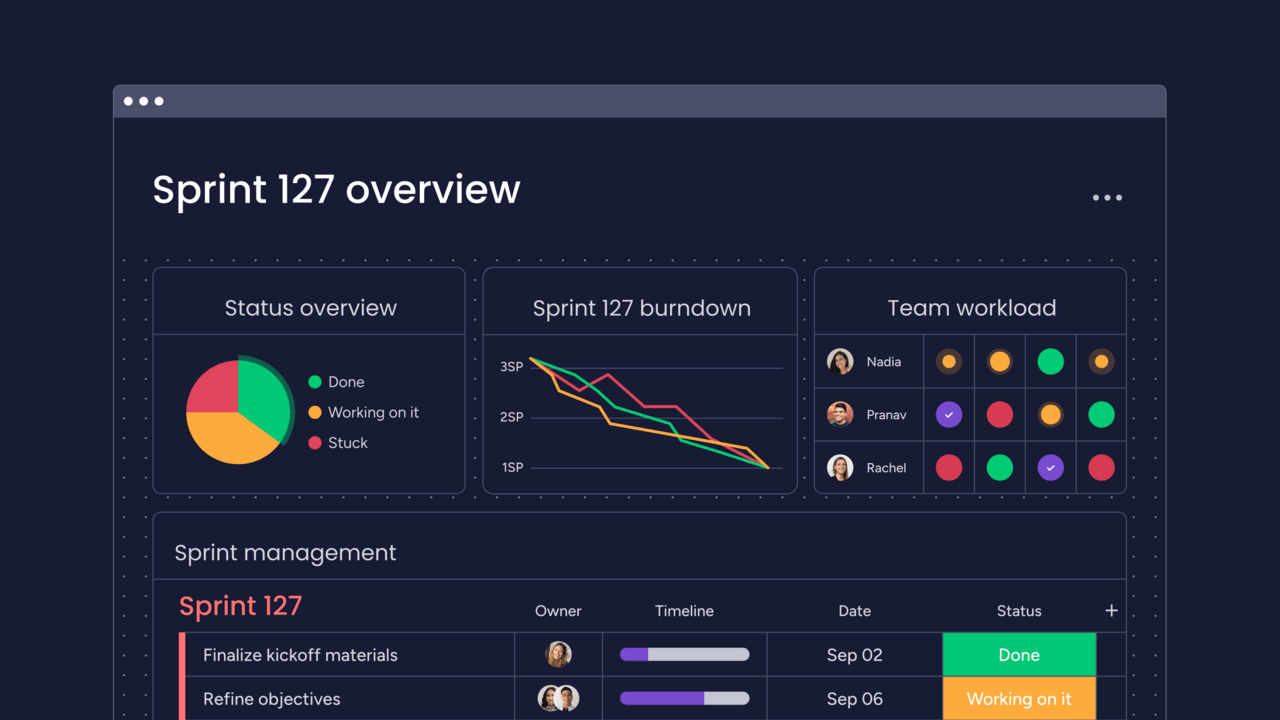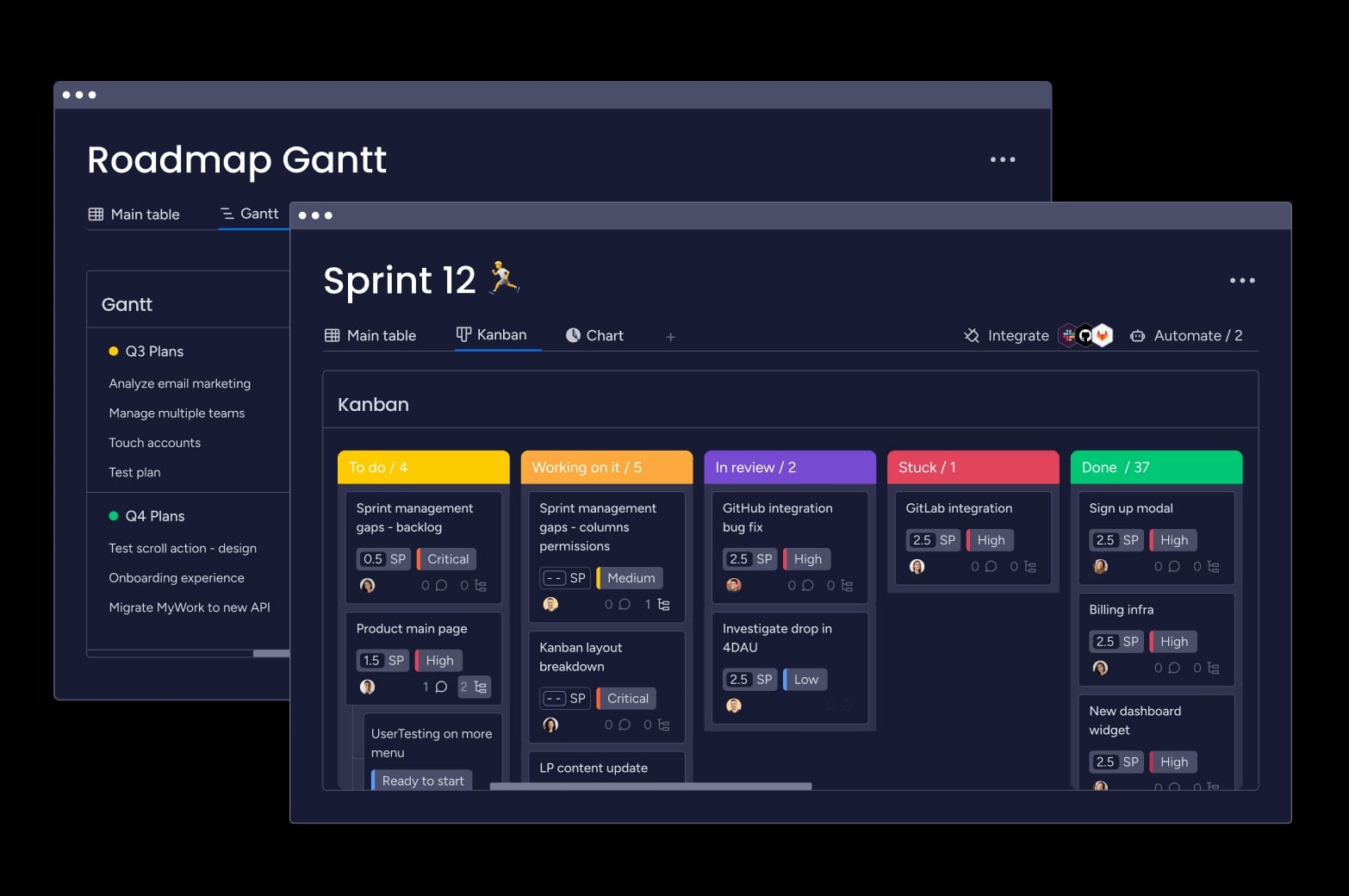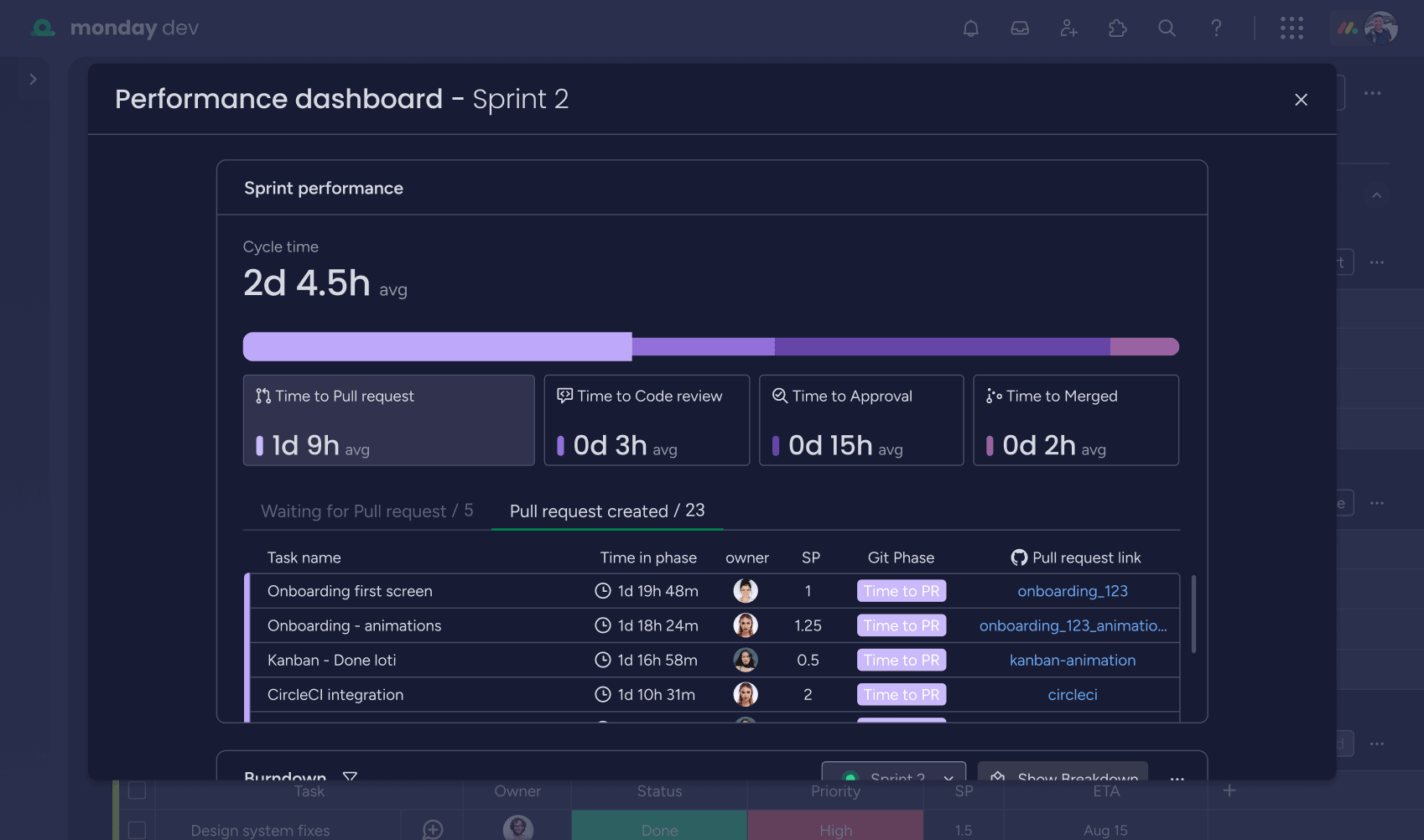Development teams are expected to deliver at speed while adapting to shifting customer needs, new technologies, and changing business priorities. Meeting those expectations in 2025 requires a way of working that combines structure with flexibility, offering predictability without slowing innovation.
Agile and Scrum are often mentioned in the same breath, but they aren’t interchangeable. Agile is a broad philosophy built on principles like collaboration, adaptability, and continuous improvement. Scrum is one of the most popular ways to put those principles into practice, providing a clear framework with defined roles, events, and artifacts.
Understanding how Agile and Scrum relate (and how they differ) is essential for teams looking to choose the right approach. In this helpful guide, we’ll break down their core ideas, explore the advantages of each, and highlight when it makes sense to use one over the other. With this clarity, you’ll be better prepared to match your methodology to your team’s needs and project goals.
Key takeaways
- Agile is the mindset, Scrum is the playbook: Agile gives you flexible principles while Scrum provides specific roles and ceremonies to follow.
- Choose based on your team’s needs: use Scrum for complex product development with stakeholders, Agile principles for creative work requiring maximum flexibility.
- Success depends on mindset change, not just process: focus on collaboration and customer value rather than just following Agile ceremonies and meetings.
- monday dev adapts to your approach: customize workflows for Scrum sprints or Agile flow while maintaining visibility through automated reporting and AI-powered insights.
- Start small and improve continuously: begin with pilot teams, invest in proper training, and use retrospectives to adapt what works for your situation.

What is Agile project management
Agile is a project management philosophy that prioritizes flexibility, collaboration, and iterative delivery. Research shows that Agile projects are four times more likely to succeed and one-third less likely to fail compared to traditional waterfall approaches. This means teams work in short cycles, deliver working solutions quickly, and adapt based on feedback rather than following rigid plans.
Think of Agile as a mindset shift from traditional project management. Instead of planning everything upfront and hoping nothing changes, you embrace change as a natural part of the process.
The 4 core Agile values
At the heart of Agile project management is the Agile Manifesto, which lays out four core guiding values. These principles shape how teams work, communicate, and deliver, ensuring that the focus stays on outcomes that matter most. Here’s how each value plays out in practice:
1: prioritize people and collaboration
Agile places individuals and interactions above processes and tools. Teams focus on direct communication and effective collaboration instead of relying too heavily on rigid systems or procedures.
2: deliver working software first
Functioning products take priority over lengthy documentation. While documentation still has its place, it exists to support the goal of delivering real value to users rather than slowing progress.
3: collaborate with customers continuously
Customer collaboration is more important than contract negotiation. Agile teams engage with customers throughout the project, ensuring that evolving needs are met and that what’s being built remains relevant.
4: Embrace change with flexibility
Instead of seeing change as a disruption, Agile treats it as an opportunity to improve. Plans are adaptable, allowing teams to adjust quickly as requirements shift.
The 12 Agile principles
The four core Agile values set the foundation for how Agile works in practice. To make those values actionable, the Agile Manifesto defines 12 principles that guide day-to-day behavior and decision-making. Where the values provide the philosophy, the principles offer the practical steps that help teams plan, collaborate, and deliver effectively.
Here are the 12 principles:
1. Early and continuous delivery
Deliver valuable software frequently, from every couple of weeks to every couple of months.
2. Welcome changing requirements
Adapt to changes even late in development if they provide customer benefit.
3. Deliver working software often
Frequent releases measure progress through functionality, not paperwork.
4. Collaborate daily with stakeholders
Business and development teams work closely together throughout the project.
5. Build projects around motivated individuals
Provide people with trust, support, and the right environment to succeed.
6. Prefer face-to-face conversation
Direct communication is the most effective way to share knowledge.
7. Working software is the primary measure of progress
Progress is judged by what works, not what’s written down.
8. Maintain a sustainable pace
Agile promotes steady, ongoing development without burnout.
9. Pay attention to technical excellence and good design
Strong engineering and thoughtful design enhance agility and reduce rework.
10. Simplicity matters
Focus on essentials by maximizing the amount of work not done.
11. Self-organizing teams achieve the best results
Teams decide how to accomplish work rather than following rigid orders.
12. Regular reflection and adjustment
Teams pause to review how they work and adapt to improve continuously.
Popular Agile methodologies
Agile is a philosophy, but teams bring it to life through specific frameworks and practices. These methodologies interpret Agile values in different ways, offering structure and tools to help teams organize work and deliver value.
- Scrum: organizes work into fixed-length sprints with defined roles and ceremonies. It’s the most popular Agile framework, with research showing that 81% of organizations use Scrum or a hybrid version of it.
- Kanban: uses visual boards to manage continuous workflow and limit work in progress, keeping delivery smooth and predictable.
- Extreme Programming (XP): promotes technical excellence through practices such as pair programming, continuous integration, and test-driven development.
- Lean: aims to eliminate waste and maximize customer value by focusing on efficiency and continuous improvement.
What is a Scrum framework?
Scrum is a specific framework within Agile that adds structure through defined roles, events, and artifacts. It helps teams develop complex products in iterative cycles called sprints, where working features are delivered regularly and refined through feedback.
While Agile sets the philosophy, Scrum provides the concrete practices that teams can adopt right away. Platforms like monday dev make it easier to apply these practices by allowing teams to design Scrum workflows that match their processes.
The 3 Scrum roles
- Product Owner: defines what gets built and prioritizes the backlog based on business value.
- Scrum Master: facilitates the process and removes obstacles blocking team progress.
- Developers: build the product increment, including anyone contributing to development.
The 5 Scrum events
- Sprint: the container for all work, typically lasting one to four weeks.
- Sprint Planning: team decides what to complete in the upcoming sprint.
- Daily Scrum: 15-minute sync where team members share progress and obstacles.
- Sprint Review: demonstration of completed work to gather stakeholder feedback.
- Sprint Retrospective: team reflection to identify improvements for next sprint.
The 3 Scrum artifacts
- Product Backlog: prioritized list of everything needed for the product.
- Sprint Backlog: items selected for the current sprint plus the delivery plan.
- Increment: working product that meets your definition of “done”.
Key differences between Agile and Scrum
Agile and Scrum are closely related but work at different levels. Agile is the philosophy built on values and principles, while Scrum is a framework that applies those ideas with defined roles, events, and artifacts.
Agile explains the why behind adaptive, collaborative development, and Scrum provides the how through a structured process. The table below shows the key differences between them.
| Aspect | Agile | Scrum |
|---|---|---|
| Nature | Philosophy and mindset | Specific framework |
| Structure | Flexible, no prescribed roles | Defined roles and ceremonies |
| Timeframes | Continuous iterations | Fixed-length sprints |
| Team size | Variable | Typically 3-9 people |
| Documentation | Minimal, as needed | Specific artifacts required |
Philosophy vs framework
Agile gives you guiding principles to shape how you think about work. Scrum gives you a playbook to follow.
You can embrace Agile thinking while using various frameworks. Or you can implement Scrum practices while gradually adopting the Agile mindset. monday dev supports both approaches with Agile workflows that accommodate your team’s needs.
Flexibility vs structure
Agile encourages you to adapt practices to fit your situation. Scrum provides consistent structure through defined roles and ceremonies.
Need flexibility? Choose Agile when working on creative projects or exploring new markets. Need structure? Choose Scrum when managing complex development or coordinating multiple stakeholders.
Scope of application
Agile principles extend beyond software to marketing, HR, and operations. Scrum was designed specifically for complex product development.
Many organizations apply Agile thinking broadly while using Scrum for product teams. This hybrid approach lets different departments embrace Agile values while choosing frameworks that match their work patterns.

The benefits of Agile methodology
Agile transforms how organizations deliver value by prioritizing customer needs and team collaboration over rigid processes. These benefits create lasting advantages that improve both competitiveness and employee satisfaction.
Rapid adaptation to change
Agile’s iterative approach lets you pivot quickly based on market feedback. Instead of committing to long-term plans, you deliver working solutions in short cycles and adjust based on results.
This reduces the risk of building products nobody wants. You can experiment with features, test strategies, and scale what works without massive change management costs.
Enhanced team collaboration
Breaking down silos between departments creates stronger working relationships. Daily communication and regular feedback sessions lead to faster decisions and more innovative solutions.
Teams report higher satisfaction when they have autonomy to make decisions and see direct impact on customer outcomes. monday dev supports this collaboration with integrated workflows that keep everyone aligned.
Continuous customer value
Rather than waiting months to deliver complete solutions, you provide value throughout development. Early delivery lets customers benefit immediately while shaping future development through feedback.
This approach ensures you build features customers actually need. You prioritize work that creates real business impact rather than just completing requirements.
Reduced project risk
Short iterations help identify problems early when they’re less expensive to fix. Regular retrospectives build organizational knowledge that reduces future risk.
How does this work in practice? You course-correct quickly rather than discovering major issues late in development. This learning culture creates resilient teams that handle unexpected challenges effectively.
The benefits of Scrum development
Scrum’s structure provides specific advantages for teams managing complex development. The framework creates predictability while maintaining flexibility to adapt with the help of a Scrum board.
Clear accountability and roles
Scrum eliminates confusion about who does what. The Product Owner focuses on maximizing value. The Scrum Master removes obstacles. Developers build solutions.
This clarity reduces conflicts and speeds decision-making. Everyone knows their responsibilities and can focus on their core work rather than getting pulled in multiple directions.
Predictable sprint cycles
Fixed-length sprints create rhythm for both teams and stakeholders. You establish sustainable work patterns. Stakeholders know when to expect deliverables. Organizations can plan releases around predictable schedules.
Sprint boundaries provide natural points for reflection and adjustment. Teams using monday dev leverage this predictability through customizable sprint boards and automated reporting.
Built-in feedback mechanisms
Sprint Reviews gather stakeholder input on functionality. Retrospectives focus on process improvement. Daily Scrums identify obstacles quickly.
These feedback loops prevent ineffective practices from continuing. You identify improvement opportunities before problems become serious.
Measurable progress tracking
Scrum makes it easy to track progress using Agile velocity, burndown charts, and sprint goals. This data supports evidence-based decisions about capacity and timelines.
Concrete metrics improve stakeholder communication. You can identify trends, predict delivery dates, and make informed scope decisions.

When to use Agile vs when to use Scrum
Agile and Scrum are not competing choices. Agile is the broader philosophy, while Scrum is one of the most widely used frameworks for putting Agile into practice. The decision is less about picking one over the other and more about deciding whether your team needs the flexibility of Agile in general or the added structure that Scrum provides.
The scenarios and factors below outline when a lightweight Agile approach makes sense on its own and when Scrum’s framework is the better fit.
Ideal scenarios for Agile
- Early-stage start-ups: need to pivot business models and explore markets without process overhead.
- Creative projects: require experimentation and iterative refinement based on discoveries.
- Cross-departmental initiatives: span teams with different working styles.
- Maintenance work: involves unpredictable issues rather than planned development.
Ideal scenarios for Scrum
- Complex product development: benefits from defined roles and regular ceremonies.
- New teams: need structure to learn effective Agile practices.
- High stakeholder involvement: requires regular reviews to maintain alignment.
- Scaling practices: provides common framework across multiple teams.
5 decision factors to consider
- Team experience level: new teams benefit from Scrum’s structure. Experienced practitioners may prefer Agile flexibility.
- Project complexity: complex projects with dependencies need Scrum’s coordination mechanisms.
- Stakeholder involvement: high involvement works well with Scrum’s ceremonies.
- Organizational culture: some cultures need structure to feel comfortable with change.
- Product type: software products fit Scrum’s model. Operational work may not need sprints.
Agile and Scrum implementation challenges
Successfully implementing Agile transformation or Scrum requires changing mindsets and building new skills. Understanding common challenges can help you prepare and develop strategies to overcome obstacles.
Common Agile pitfalls
- Lack of leadership support: transformations fail when executives expect immediate results without providing resources or cultural change, a problem made worse by a significant perception gap — while 45% of senior leaders believe change is managed well, only 23% of individual contributors agree.
- Resistance to change: team members resist new practices when comfortable with existing processes.
- Misunderstanding principles: tuperficial adoption creates “Agile theater” without real benefits.
Typical Scrum obstacles
- Incomplete sprints: poor planning leads to unfinished work that undermines predictability.
- Ineffective ceremonies: meetings become ritualistic rather than valuable collaboration.
- Role confusion: traditional management structures conflict with Scrum accountabilities.
Proven solutions for success
- Start small: begin with pilot teams to build expertise before scaling.
- Invest in training: ensure teams understand principles through proper education, and employees agree: 60% believe better training is the key to improving change management.
- Focus on outcomes: measure value delivered rather than practice adherence.
- Continuous improvement: mse retrospectives to adapt based on what works.
To support these practices, platforms like monday dev provide flexible workflows that grow with your team, making it easier to scale, measure progress, and refine processes over time

Agile vs other methodologies
No single methodology works for every project, and Agile is just one of several approaches teams can take. The right choice depends on factors like complexity, predictability, and how much flexibility you need along the way. By comparing Agile with other methods such as Waterfall, Scrum, and Kanban, it becomes easier to see where each one fits best.
Agile vs Waterfall
Agile vs Waterfall is one of the most common comparisons in software and product development. Agile relies on iterative delivery and constant feedback, while Waterfall follows a structured, sequential approach. The table below highlights the key differences that influence planning, flexibility, and risk management.
| Aspect | Agile | Waterfall |
|---|---|---|
| Approach | Iterative delivery | Sequential phases |
| Change handling | Embraces change | Change is expensive |
| Customer involvement | Continuous collboration | Limited to requirements phase |
| Risk management | Early feedback reduces risk | Detailed planning addresses risk |
Scrum vs Kanban
The main difference between Kanban vs Scrum is that they are both Agile frameworks, but they structure work in very different ways:
- Scrum: organizes work into fixed-length sprints with clearly defined roles (Product Owner, Scrum Master, Development Team) and ceremonies such as sprint reviews and retrospectives. This structure works best for complex product development where priorities shift and stakeholder feedback is essential.
- Kanban: manages work through a continuous flow system, using visual boards and work-in-progress (WIP) limits to keep tasks moving smoothly. This approach suits support teams or operational work that requires flexibility and steady throughput without sprint cycles.
When to choose:
- Choose Scrum for product development projects with changing requirements, high stakeholder involvement, or a need for structured collaboration.
- Choose Kanban for ongoing support work, maintenance tasks, or environments where flexibility and continuous delivery matter most.
Transform your development process with monday dev
Choosing between Agile and Scrum is just the beginning. The real challenge? Implementing these approaches while maintaining visibility and coordination.
monday dev provides a comprehensive platform supporting both Agile thinking and Scrum practices. Your team can customize workflows without losing structure and transparency.
Flexible workflows for any methodology
Create custom workflows supporting your chosen approach — structured Scrum sprints, flexible Kanban flow, or hybrid methods. Customizable boards and templates accommodate different preferences without forcing rigid structures.
Start with simple workflows and add complexity as your team matures. Custom fields, automated workflows, and built-in integrations with GitHub, Jira, and GitLab let you visualize work in ways that make sense for your context.
Real-time visibility without friction
Get transparency and progress tracking without administrative overhead. Interactive dashboards, burndown charts, and velocity tracking provide instant insights while automated reporting keeps everyone informed without manual updates or lengthy meetings.
Real-time notifications and @mentions ensure stakeholders stay informed without interrupting development flow. This visibility supports both Agile transparency and Scrum artifacts management, with dedicated views for product backlogs and sprint planning.
AI-powered sprint intelligence
AI takes on routine work while giving teams insights that drive smarter decisions and faster delivery. Instead of spending hours on manual updates, teams can stay focused on solving problems and shipping value.
- Automated support: categorize work items, extract document details, generate sprint summaries, and draft user stories automatically.
- Specialized digital workers: Project Analyzer identifies bottlenecks and predicts delivery risks, while Code Reviewer helps maintain quality standards.
- Continuous improvement: AI-powered retrospective analysis highlights patterns across multiple sprints, allowing teams to catch issues early and refine processes over time.
Seamless collaboration across teams
Break down silos with cross-functional boards that connect development work to broader business objectives. Embedded code snippets, file sharing, and in-context discussions eliminate context switching and keep technical conversations organized.
Customizable permissions ensure the right stakeholders have appropriate access while protecting sensitive information. With automated dependencies and roadmap views, teams can coordinate complex initiatives while maintaining their preferred working style.
Frequently asked questions
Is Scrum part of Agile methodology?
Yes, Scrum is a framework that implements Agile principles. It's one specific way to practice Agile, providing concrete practices for putting Agile philosophy into action.
Can you use Agile without Scrum?
Yes, you can follow Agile principles using other frameworks like Kanban, Extreme Programming, or custom approaches. Agile is about mindset and values, not specific practices.
Do you need certification for Agile or Scrum?
Certifications can help with learning but aren't required to practice effectively. Many successful teams focus on understanding principles and adapting practices to their context rather than pursuing credentials.
Which is more suitable for software development projects?
Both work well for software development. Scrum provides more structure for complex projects with its defined roles and sprint cycles, while Agile principles offer flexibility for various project types.
How long does Agile transformation typically take?
Agile transformation typically takes 6-18 months for teams to become proficient. It's an ongoing journey of continuous improvement rather than a destination with a fixed endpoint.
What team size works best for Scrum teams?
The recommended Scrum team size is three to nine people. This range supports effective collaboration while avoiding coordination challenges that come with larger groups.
 Get started
Get started 


